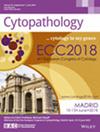Evaluation of Diagnostic Accuracy of the Paris System (TPS 2.0) in Urine Cytology Specimens: An Institutional Experience From a Large Cohort of a Tertiary Care Centre
Abstract
Objective
The objective of this study is to evaluate the diagnostic performance of urine cytology using The Paris System (TPS 2.0) in comparison with TPS 1.0, and the Four-Tier Reporting System (FTRS) of our institute for identifying high-grade urothelial carcinoma (HGUC).
Methodology
A total of 789 urine cytology specimens from 240 patients including 12 UTUC cases with available histological and clinical details were included. Two hundred twenty-two cases were newly diagnosed, whereas 18 were recurrent tumours. Histopathological evaluation categorised the cases as non-neoplastic (33%, 13.7%), low-grade urothelial neoplasms (LGUNs) (94%, 39.2%), high-grade urothelial carcinoma (HGUCs) (110%, 45.8%) and other malignancies (3%, 1.3%).
Results
TPS 2.0 categorised the cases as 14 (5.7%) non-diagnostic or ND/U, 99 (41.5%) NHGUC, 37 (15.4%) AUC, 24 (10%) SHGUC and 66 (27.5%) HGUC. TPS 1.0 had 14 (5.7%) ND/U, 72 (30%) NHGUC, 61 (24.5%) AUC, 3 (1.3%) LGUC, 24 (10%) SHGUC and 66 (27.5%) HGUC. FTRS classified them as 19 (7.5%) ND/UNS, 44 (18.3%) NEG, 88 (36.7%) INC and 89 (37.1%) POS. The ROHM for TPS 2.0 was 71.4% for ND/U, 12.1% for NHGUC, 29.7% for AUC, 79.2% for SHGUC and 89.4% for HGUC. TPS 1.0 showed a similar ROHM for ND/U, SHGUC and HGUC, whereas had 13.8% for NHGUC and 19.7% for AUCs. FTRS, had 78.9% for UNS, 6.8% for NEG, 35.2% for INC and 73.1% for POS. TPS demonstrated a sensitivity of 70.91% and specificity of 90.77% for identifying HGUC, whereas FTRS showed 59.09% sensitivity and 81.54% specificity. Also, TPS was found to be 75% accurate with 62.5% sensitivity and 100% specificity for UTCC cases separately.
Conclusion
TPS 2.0 exhibits diagnostic accuracy with better performance in comparison to FTRS, making it a more reliable system for clinical practice. Our findings endorse the utility of TPS 2.0 in improving the accuracy of urine cytology in predicting histological diagnosis of HGUC.


 求助内容:
求助内容: 应助结果提醒方式:
应助结果提醒方式:


